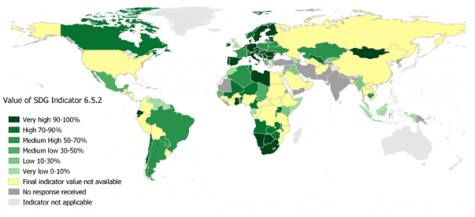Across the world, 153 countries share rivers, lakes and aquifers. Transboundary basins cover more than half of the Earth’s land surface, account for an estimated 60 per cent of global freshwater flow and are home to more than 40 per cent of the world’s population. Transboundary water cooperation is therefore not only key for water management but also, more generally, for sustainable development, regional integration and peace.
On 4 March, at a joint online event to launch the UN-Water Sustainable Development Goal (SDG) 6 Summary Progress Update 2021, UNECE and UNESCO presented the first results of the second reporting exercise on indicator 6.5.2 carried out in the period 2020–2021.
The findings are based on countries’ reports on SDG indicator 6.5.2, measuring transboundary water cooperation, for which UNECE and UNESCO are co-custodians. Despite the COVID-19 pandemic, more than 80 per cent of countries sharing transboundary waters have submitted data on transboundary water cooperation, compared to 70 per cent in 2017. Of the 153 countries sharing transboundary rivers, lakes and aquifers, 128 responded to the invitation to report. This marks an important step forward in monitoring progress on transboundary water cooperation at the global level.
The exercise shows that a significant acceleration of progress is needed: out of the 101 countries where SDG indicator 6.5.2 can be calculated, only 24 reported that all their transboundary basins are covered by cooperation arrangements, with an additional 22 having high levels of cooperation. Transboundary cooperation is particularly advanced in Europe, North America and sub-Saharan Africa. In Latin America and Asia, despite notable exceptions, many transboundary basins still lack operational arrangements for water cooperation.

As the only indicator that is exclusively dedicated to transboundary cooperation, indicator 6.5.2 can provide an important driver for progress on other related SDGs on poverty, hunger, human health and well-being, energy, climate action, marine and terrestrial ecosystems and peace.
Preliminary results also show a lack of progress regarding cooperation on transboundary groundwaters in particular. Operational arrangements for transboundary aquifers are still rare around the world and cooperation on aquifers is not sufficiently integrated with that on surface waters.
This preliminary analysis therefore calls for progress to be accelerated. In particular, it encourages countries lacking operational arrangements to identify and advance key factors of operationality, such as the holding of regular meetings and the exchange of data between riparians that might result in “quick wins” that accelerate the achievement of targets across many SDGs.
It also incites countries to build on the 1997 Convention on the Law of Non-Navigational Uses of International Watercourses, the 1992 Convention on the Protection and Use of Transboundary Watercourses and International Lakes (Water Convention) and the 2008 International Law Commission’s Articles on the law of transboundary aquifers. These instruments, and particularly the Water Convention through its intergovernmental framework, offer tools for negotiating new arrangements or strengthening existing arrangements.
The full second progress report on SDG indicator 6.5.2 will jointly be launched in August 2021 by UNECE and UNESCO as co-custodians.
Note to editors
SDG indicator 6.5.2 assesses the level of progress towards achieving target 6.5, which calls for the implementation of integrated water resources management at all levels, including through transboundary cooperation.
SDG indicator 6.5.2 measures the proportion of a transboundary basin area (river, lake or aquifer) within a country with an operational arrangement for water cooperation in place. An “arrangement” might include a bilateral or multilateral treaty, convention, agreement or other formal arrangement among countries that provides a framework for cooperation on transboundary basins.
The four following criteria must be met for an arrangement to be considered “operational”:
-
A joint body or other institutional mechanism must be in place.
-
There must be at least one annual (political or technical) meeting between riparian countries.
-
There must be at least one annual exchange of data and information.
-
Riparian countries must have adopted joint or coordinated management plans, or joint objectives.
The progress report on SDG indicator 6.5.2 is prepared by UNECE and UNESCO on behalf of UN-Water as part of a series of reports that track progress towards the various targets set out in SDG 6 using the SDG global indicators, prepared by the respective custodians.
Through the UN-Water Integrated Monitoring Initiative for SDG 6, the United Nations seeks to support countries in monitoring water- and sanitation-related issues within the framework of the 2030 Agenda for Sustainable Development, and in compiling country data to report on global progress towards SDG 6 (see www.sdg6monitoring.org).
Websites:
SDG 6 Summary Progress Update 2021: www.unwater.org/publications/summary-progress-update-2021-sdg-6-water-and-sanitation-for-all/
SDG indicator 6.5.2 Progress Update 2021: https://un-water.exposure.co/transboundary-water-cooperation
UN-Water SDG6 monitoring: https://www.sdg6monitoring.org/indicator-652
UN-Water SDG6 data portal: https://www.sdg6data.org/indicator/6.5.2
UNECE SDG 6.5.2 web page: http://www.unece.org/water/transboundary_water_cooperation_reporting.html